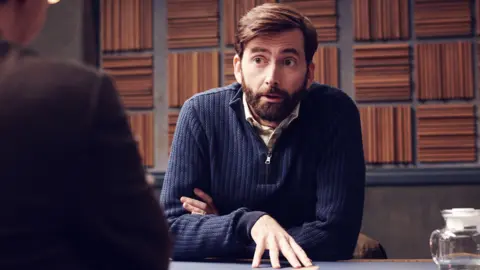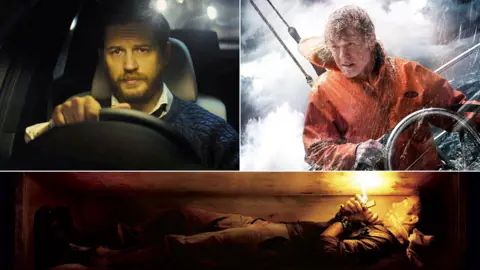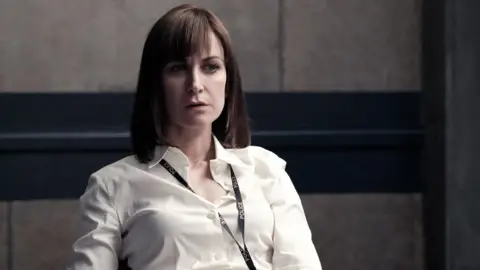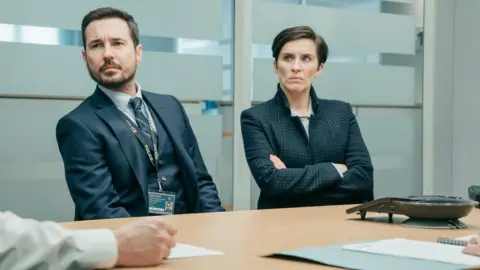Criminal on Netflix: The restrictions of film and TV confined to one location
 Netflix
NetflixUnusually for a crime drama, there are no car chases, shoot-outs, explosions, kidnappings or violent attacks in Netflix's Criminal. Well, not on screen anyway.
The series is set almost entirely in a police interview room, where suspects (played by a guest cast including David Tennant and Hayley Atwell) are interrogated as detectives try to ascertain their guilt or innocence.
Without being shown the crimes in question, our opinions as viewers are formed purely on the basis of what the suspects say and how they behave in their interviews.
The only other two places seen in Criminal are the adjoining observation room, where police can watch what's going on from the other side of a two-way mirror, and an area outside where detectives can get a coffee on their breaks.
"We were really excited by that constraint," says George Kay, showrunner and writer on Criminal. "Because I think, without being too grand, you don't need any more than three rooms in any kind of drama.
 Jose Haro
Jose Haro"You've got the action, the observation room next door, and a third space, which we always had as an unofficial rule where people would tell the truth or take a breather, the kind of downtime space.
"I always had the feeling that I never needed to find another space - there is always a solution to be found in the next room along. And so we're just rotating these, the characters and their situation and complicating it."
Often, TV series use a changing backdrop as a way to keep viewers engaged.
Political drama The West Wing, which was set in the fairly dark and drab halls of The White House, became famous for its so-called "walk and talk" scenes, where key conversations between characters would take place on walks through the halls between meetings.
The busy, bustling backgrounds helped keep viewers engaged during scenes where the characters were sometimes discussing the more mundane elements of government legislation.
But when you're confining your storyline to a single location, there are limited tactics a writer and director can employ.

Single set films
 Lionsgate/A24
Lionsgate/A24- Ryan Reynolds wakes up at the beginning of Buried to find that, having been knocked unconscious in an attack, he is now trapped underground in a wooden coffin. The film sees him trying to figure out what's happened, where he is - and whether he can escape.
- Locke, starring Tom Hardy, is set entirely in the car of the lead character Ivan Locke. Over 90 minutes, he conducts a series of speakerphone conversations on the journey as he tries to juggle crises in both his personal and professional life.
- Robert Redford stars as a man lost at sea in All Is Lost. Redford was the only cast member, and the movie had minimal dialogue. His character awakes one morning to find water flooding his boat after colliding with a shipping container, and he must figure out how to survive on his own.
The BFI also highlights 12 Angry Men, Tape, Autumn Almanac, Shirin and Alfred Hitchcock's Rope in their own list of single-setting films.

Speaking about Buried in an interview with The Film Stage, Ryan Reynolds said: "The biggest fear I had going in was that I had to do a movie in close up. You can't lie in a close up.
"We can't cut to an exterior central park, we can't cut to another actor, we can't cut to the people I'm talking to. It presented a really unique opportunity, but it was also a huge challenge to have to convey the full spectrum of human emotion in full close up and really have no gimmicks or tricks."
Katherine Kelly, who plays one of the detectives in Criminal, says she found it "liberating" to be constrained by one setting.
"There's a lot of responsibility on the actors, because there's nothing to hide behind," says Kelly, who is known for Coronation Street and Mr Selfridge.
 Netflix
Netflix"There's not a huge explosion, or a chase or anything like that. I relish that in the same way that I guess a professional sports man or woman would relish it when it comes to the game. You've done all this practice for years and years, and then it's your turn to step up.
"And I felt liberated from the changing of costumes and making sure that your hair's right and moving locations, where you're all good to go and then we've got stand down for an hour, you know, there's a lot that comes with it."
As a result of the static location, the series was shot at a much quicker rate than is normal for a TV show.
"The amount of time that the camera's rolling for is actually quite short, even though filming days are often 14 or 15 hours," Kelly says. "You'll often get about three pages, whereas we were filming more like 10 to 12 pages worth of footage [per day]. And I found that really satisfying to do."
Jim Field Smith, director and showrunner on Criminal, says: "It's like a fish bowl - it doesn't matter what size it is, because it's all about how macro you get with the details that are within it.
"And so part of the joy for us, having worked on shows that have a much bigger production-scape, was to go the other way and say, 'we're going to zoom right in on the absolute smallest detail'.
Coincidentally, the last episode of the most recent series of Line of Duty had a similar premise, taking place largely in an interrogation room.

But Kay and Smith say they weren't influenced too heavily by other films and shows which were set in one place.
"Locke is right up my street," says Kay. "They're all creative challenges. They're just traps you put yourself in to see if you can get out. So gently, we were aware of these things, but we didn't kind of study them - we wanted to bring our own take to the confined situation."
Smith says viewers will be forced to notice small details as a result of the format. In the opening episode, for example, a key piece of tension and plot development is built around whether Tennant's character is going to pick up a pen lying on the desk in front of him.
Whether or not he fidgets with it could be a sign of whether he's lying or not.
"Once you're in the room, you're pretty much stuck there," says Smith. "And I think photographically, I wanted to try and imbue some of that sensibility into the show, the fact that when someone's sitting in a chair, and they're talking, we are just staring at them. The frame is, by and large, locked.
"And as a result of that, the viewer starts to look at all the details in that frame, because they're not being distracted by 400 other things. And so you start to zero in, and because it's the kind of show you're watching, and as a viewer you know you're being asked to do that."
